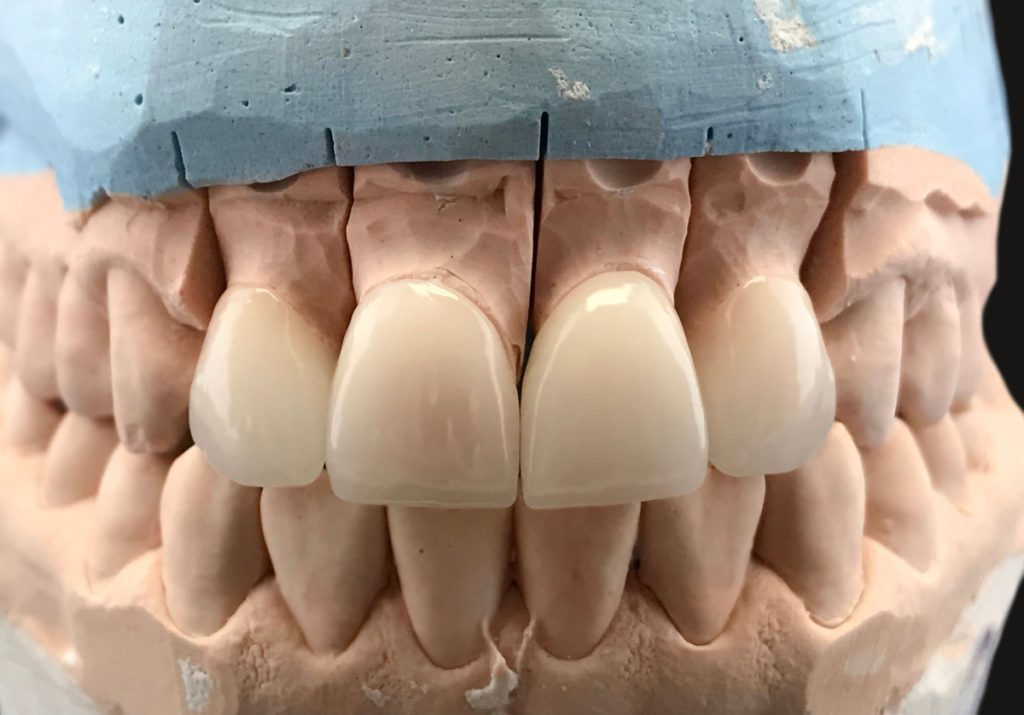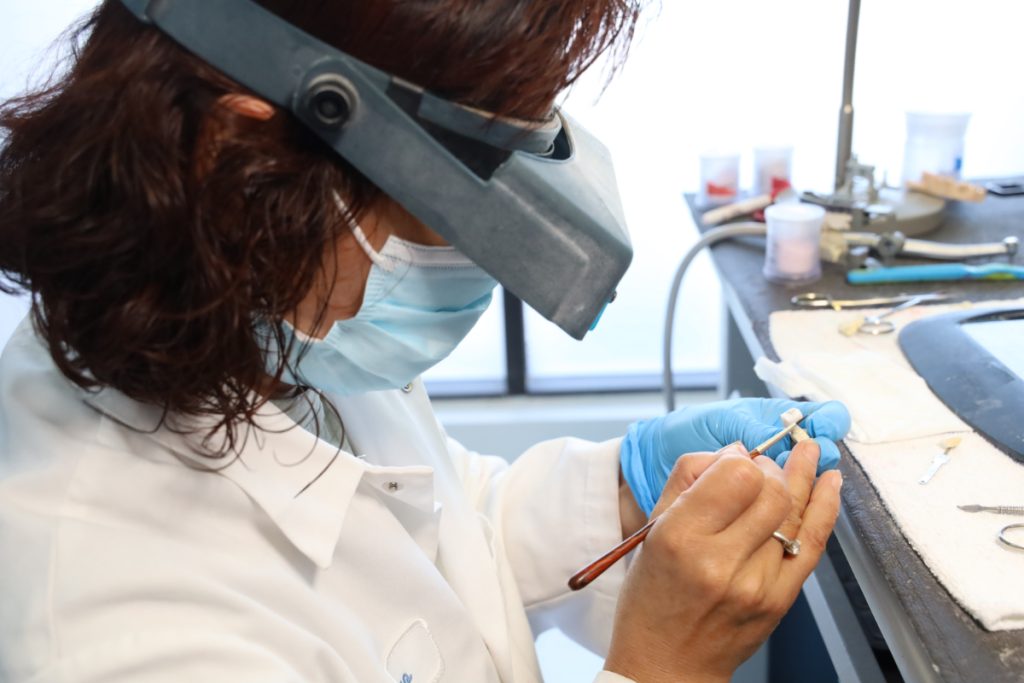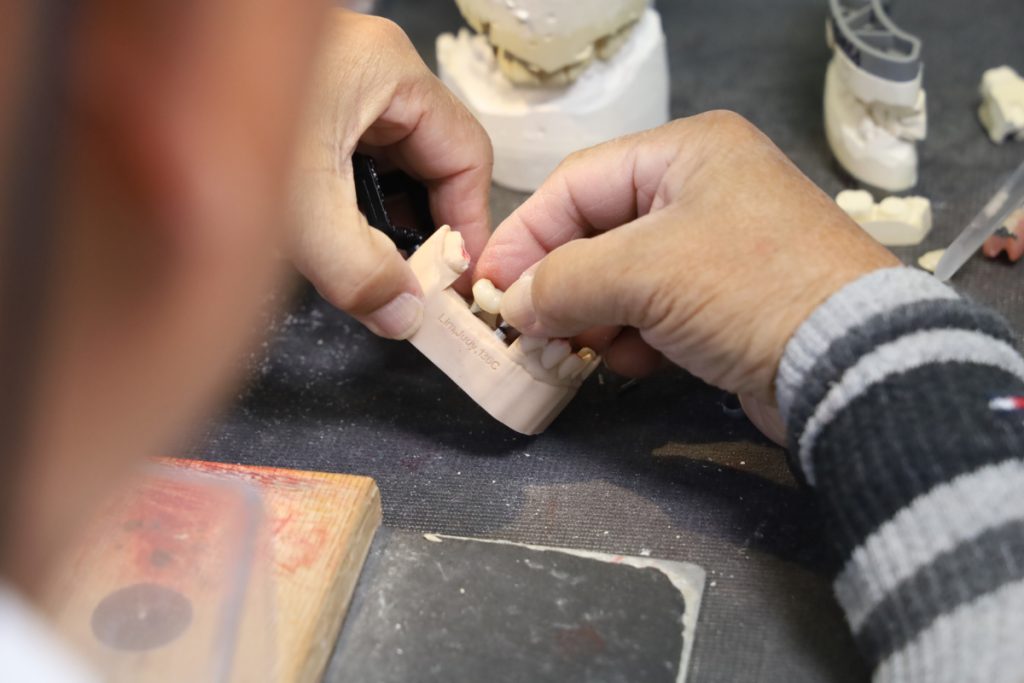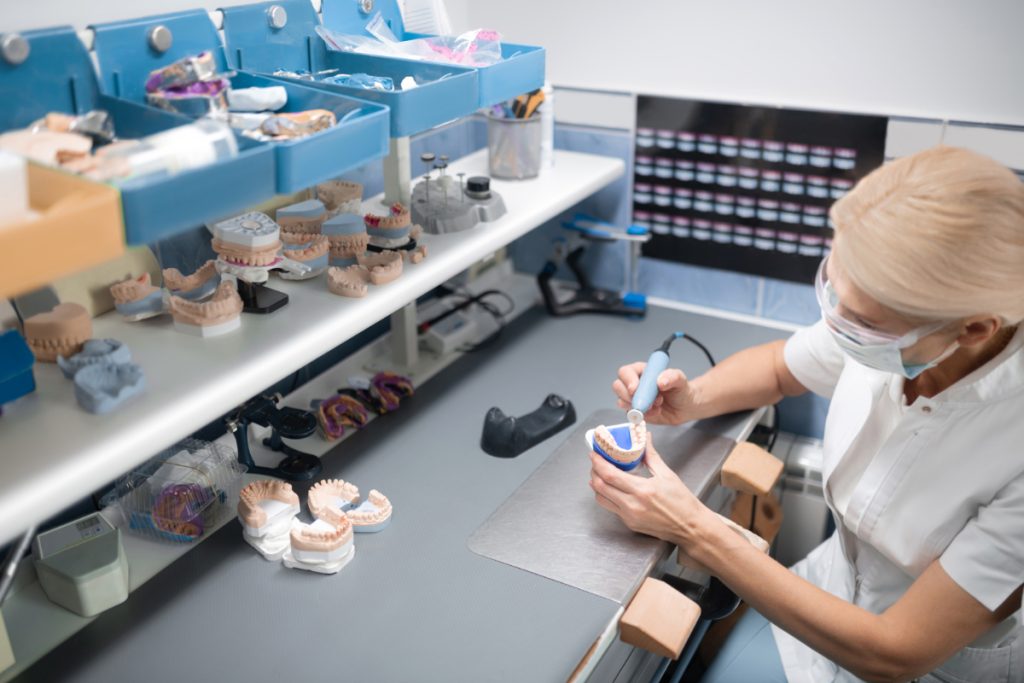
In restorative dentistry, selecting appropriate materials is paramount to achieving precise, predictable, and lasting clinical outcomes.
This guide provides a comprehensive comparison of two leading dental materials: lithium disilicate (commonly known by the brand name e.max) and zirconia.
Watersedge Dental Laboratory covers both materials’ unique properties and applications, establishing the critical distinctions so that dental professionals can make well-informed decisions, provide optimal patient care, and ensure predictable treatment results.
- Material Composition of E.max and Zirconia
- Properties and Characteristics of E.max and Zirconia
- Applications of E.max vs. Zirconia
- Cost of E.max vs. Zirconia
- Fabrication Processes of E.max and Zirconia
- Consultation and Support
[Contact Us For E.Max And Zirconia Restorations]
Material Composition of E.max and Zirconia
E.max
E.max, as it is most commonly referred to, is the brand name for lithium disilicate, a glass-ceramic material. It is not a metal or a polymer but a specialized glass with a crystalline structure.
With its excellent aesthetic properties and strong bondability through etching, lithium disilicate allows dental professionals to achieve highly natural and durable restorations that blend seamlessly with other natural teeth.
Zirconia
Zirconia is primarily composed of zirconium, an element on the periodic table classified as a metal. However, dental zirconia is not a pure metal; it is a ceramic material composed of zirconium combined with other elements. To enhance its performance in dental restorations, zirconia includes stabilizing elements such as yttrium, which help balance strength and aesthetic qualities.
Zirconia is available in various grades, allowing clinicians to select the best option for each case. Unlike e.max, it cannot be etched with hydrofluoric acid and instead relies on aluminum oxide sandblasting for surface preparation.
Properties and Characteristics of E.max and Zirconia

Aesthetics and Translucency
E.max
E.max offers exceptional aesthetics and translucency, making it an ideal choice for restorations that closely mimic the natural appearance of real teeth.
Its high translucency allows e.max to closely mimic the appearance of natural teeth, which is essential for creating restorations that blend seamlessly with the surrounding dentition, particularly in the anterior region where aesthetics are critical.
E.max effectively mimics the value of natural teeth, both in colour and in how light interacts with the tooth’s surface. It is available in multiple levels of translucency, offering dental professionals the flexibility to choose the most appropriate option based on each case’s specific needs and customize aesthetic outcomes with a more subtle, natural look or a brighter appearance.
The inherent translucency of e.max is not ideal for cases with significant underlying tooth discoloration, as the darkness can show through the restoration. In such cases, the use of other materials can be considered to mask the underlying tooth structure.
Zirconia
Aesthetically, zirconia offers strong masking properties, making it suitable for posterior restorations where strength is prioritized over achieving a highly natural appearance.
Zirconia has a lower level of translucency than e.max. It is more opaque, limiting the amount of light that can pass through. This is beneficial, especially when masking underlying tooth discolorations such as discoloured stumps from amalgam buildups and metal posts.
However, zirconia’s opacity makes it less suitable for highly aesthetic applications in the anterior region, as it does not achieve the same lifelike quality as natural teeth.
Strength and Durability
E.max
E.max is a robust material that offers sufficient strength for a wide range of restorative applications. Its strength—approximately 550 to 580 megapascals—is capable of functioning effectively for many years, especially where aesthetics are a primary concern.
While e.max is not considered delicate, its tensile strength is lower than that of zirconia, and it is more prone to fracture than zirconia under extreme forces. This limitation is critical for treatment planning and requires careful consideration when planning treatments involving high functional loads.
Zirconia
Zirconia’s impressive strength and fracture resistance make it a reliable material for demanding applications where durability is a top priority. Its exceptional performance also makes it a leading choice for implant-supported restorations where long-term performance is critical. It is also suitable for patients with bruxism or who chew ice.
The amount of yttrium incorporated into zirconia significantly influences its mechanical and aesthetic properties. Two common grades are 3Y and 4Y. 3Y zirconia is formulated with less yttrium, making it stronger and more durable but less aesthetic. 4Y zirconia, with a higher yttrium content, offers enhanced translucency and a more lifelike appearance while slightly compromising the strength.
The ability to choose between different grades of zirconia allows dental professionals to tailor material choices to each patient’s specific needs. Depending on the grade, it can be 50-150% stronger than e.max in terms of the amount of force it can withstand before fracturing. This makes it a suitable material for high-stress areas. For posterior restorations where strength is paramount, 3Y zirconia is ideal, and 4Y zirconia is preferred for anterior restorations.
Watersedge offers multiple zirconia formulas to allow dentists to choose the best balance of aesthetics and strength for each case.
Bondability and Surface Treatment
E.max
E.max creates an exceptional bond with natural tooth structure through chemical etching and silane application, ensuring strong adhesion to dental cements.
The etching process utilizes hydrofluoric acid to create microscopic irregularities on the intaglio surface—the internal aspect of the crown or veneer that comes into contact with the enamel of the patient’s tooth. These microabrasures significantly increase the surface area available for bonding, resulting in improved retention.
Following etching, a silane coupling agent is applied to the treated surface, acting as a bridge that chemically links the e.max to resin-based dental cements. This process strengthens the chemical bond and increases the restoration’s stability and longevity.
Zirconia
Zirconia relies primarily on mechanical retention for bonding, as it cannot be etched with hydrofluoric acid like e.max. This is because zirconia is composed mainly of zirconium, a metal.
Because it cannot be etched, zirconia requires a different treatment to prepare it for bonding. Typically, the intaglio surface is sandblasted with aluminum oxide to create a clean and slightly roughened surface. The bond between zirconia and dental cement relies primarily on mechanical interlocking to promote retention rather than a combination of chemical and mechanical bonds.
Due to the lack of chemical bonding, zirconia is less suitable for restorations with minimal tooth preparation (for example, veneers), where achieving a strong and durable bond is critical for long-term success.
Transitioning from PFM to E.max vs. Zirconia
While e.max and zirconia provide a range of benefits, some clinicians may still prefer traditional porcelain fused to metal (PFM) restorations. However, it’s important to recognize that modern materials like e.max and zirconia offer distinct advantages in aesthetics, strength, and biocompatibility.
The team at Watersedge is available to discuss any questions or concerns you may have about incorporating e.max and zirconia into your practice.
[Contact Us For E.Max And Zirconia Restorations]
Applications of E.max vs. Zirconia

Veneers
E.max is preferred for veneers based on its exceptional aesthetics and the ability to be etched and silanated, which allows for a strong and reliable bond to the prepared tooth surface. Additionally, the translucency of e.max enables it to mimic the natural appearance of teeth, making it ideal for cosmetic procedures involving anterior teeth.
Zirconia is not recommended for veneers due to its bonding limitations and opacity. Achieving a reliable bond to a single prepared tooth surface is difficult, resulting in poor retention and increasing the risk of debonding over time.
While some veneer dental laboratories offer zirconia veneers, Watersedge Dental Laboratory does not recommend zirconia for anterior restorations where the goal is to achieve a highly aesthetic outcome.
Crowns
Both e.max and zirconia are viable options for dental crowns, depending on the location and functional requirements of the restoration.
E.max crowns are well-suited for anterior restorations, where translucency and achieving a very realistic-looking tooth are crucial for achieving a natural appearance. The bondability of e.max is also beneficial for full crown restorations, providing a stable and long-lasting restoration.
Zirconia offers superior strength, making it an ideal choice for posterior crowns and areas of the mouth exposed to high masticatory forces. Additionally, because of its opacity, it can effectively mask discoloured tooth structure, making it suitable for cases with underlying stains or metal posts. Dental practitioners can choose from multiple grades of zirconia for crown restorations, ranging from the strongest, least aesthetic options to those that offer enhanced aesthetics with a slight compromise in strength.
Zirconia crowns require a minimum amount of tooth structure to achieve predictable retention. To ensure proper retention and long-term stability, it is generally recommended that a posteriorly prepared tooth have at least 4mm of vertical height.
Bridges
When planning fixed restorations such as dental bridges, Watersedge offers expert guidance to help dental practitioners determine whether e.max or zirconia is the most suitable choice based on the unique needs of each case.
Due to its limited strength over long spans, e.max isn’t typically recommended for traditional three-unit or longer bridges over a long, edentulous span, but the material is suited for single-unit Maryland bridges that demand less support.
Zirconia is a more suitable material for traditional bridges, often used to replace missing teeth. Its high tensile strength and durability make it a reliable choice for restorations that must withstand significant occlusal forces. Multiple grades allow dental professionals to balance strength and aesthetics based on each patient’s needs. However, due to its bonding limitations, zirconia is not typically recommended for Maryland bridges.
Inlays and Onlays
Inlays and onlays are conservative restorative solutions that preserve natural tooth structure while offering strength and aesthetics. E.max and zirconia are both commonly used for these restorations, with each material offering unique benefits.
Onlays, often compared to veneers, are designed specifically for the occlusal surface, providing coverage and protection for larger areas, while inlays fit within the tooth structure, preserving the buccal and lingual walls.
Watersedge Lab generally recommends e.max for both inlays and onlays due to its bondability and aesthetic qualities, making it a versatile option for either type of restoration. We recommend zirconia on a case-by-case basis, particularly in situations where additional strength is required, although retention challenges should be carefully evaluated.
Interocclusal Space Considerations
The available interocclusal space is a critical factor influencing the selection of materials for restorations. Both e.max and zirconia have minimum thickness requirements but differ in their ability to perform under limited space conditions.
While e.max is a strong material, it requires more thickness to achieve its full strength. Unlike zirconia, e.max cannot be fabricated as thinly while maintaining its durability, making it more prone to failure when reduced to minimum thickness. As a result, in cases with limited space, e.max may not be the ideal choice due to the increased risk of fracture when made too thin.
Conversely, Zirconia is well-suited for restorations with limited interocclusal space, as it can be fabricated thinner than e.max while still retaining its high strength. This makes zirconia a more versatile option in space-constrained cases, providing the necessary structural integrity even at minimal thicknesses.
Cost of E.max vs. Zirconia
At Watersedge Dental Laboratory, the focus is on helping dental professionals choose the most appropriate material—e.max or zirconia—based on the unique clinical needs of each patient rather than cost. While the price of an e.max veneer and crown is the same, the decision should be guided by factors such as function, aesthetics, and longevity. Although zirconia is a more economical option, the choice of material should prioritize critical considerations such as restoration location (anterior vs. posterior), translucency needs, strength requirements, and tooth preparation.
Fabrication Processes of E.max and Zirconia

E.max
E.max restorations can be fabricated using a variety of techniques. The choice depends on the specific requirements of the case, with hand-layered techniques offering greater customization for complex preparations and those requiring a more intimate fit. This is especially true when dealing with unique prep designs with sharp corners or an occlusal table with bumps, valleys, and troughs.
The lost wax technique involves hand-sculpting the restoration in wax against the prepared tooth on a model. This allows for a precise fit that closely replicates the natural tooth structure, ensuring an accurate, seamless adaptation to the prepared tooth.
Milling e.max restorations is ideal for standard preparations with straightforward designs, allowing restorations to be fabricated from a solid block of lithium disilicate with high precision. At Watersedge, we mill e.max restorations when we are confident that this approach will deliver an accurate and predictable fit for crowns or veneers.
Zirconia
Zirconia restorations are primarily fabricated using computer-aided design/computer-aided manufacturing (CAD/CAM) processing. This digital approach allows for precise design and milling of restorations from a solid zirconia block, utilizing advanced technologies to ensure consistent and predictable results.
Watersedge Consultation and Support
At Watersedge, we are committed to helping dental professionals select the ideal material for each unique case. Our expertise supports better treatment planning and elevates the standard of care for every patient.
Both e.max and zirconia are long-lasting, high-quality materials, and Watersedge stands behind every restoration we produce. We offer free case consultations to provide dental professionals with expert guidance in choosing the best treatment options—ensuring that each case is approached with the most informed strategy at no cost to the practice.
Watersedge also leverages advanced technology, including intraoral scanners that capture the patient’s oral environment in detail. This allows us to review scans, assess colour and structure, and collaborate with dentists before any work begins.
By collaborating closely with dental professionals, we enhance case predictability and achieve optimal patient outcomes.
